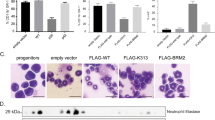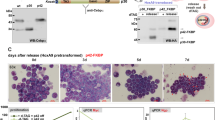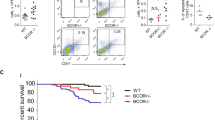Abstract
CCAAT/enhancer binding protein epsilon (C/EBPε) is essential for terminal granulocytic differentiation. Its expression begins at the transition between the proliferative and non-proliferative compartments of myelopoiesis. We studied the effect of targeted disruption of the C/EBPε gene on murine myeloid proliferation and apoptosis. Bone marrow cellularity of C/EBPε −/− and wild-type mice was 95% and 65%, respectively. The C/EBPε −/− mice had an expansion in the number of their CFU-GM/femur. The number of myeloid committed progenitor cells in the peripheral blood and the spleen of these mice was also increased. Bromodeoxyuridine (BrDU) pulse labeling studies demonstrated that the fraction of actively proliferating cells was two-fold higher in the bone marrow of C/EBPε −/− mice. However, the number of myeloid colonies arising from purified Sca-1+/lin− early hematopoietic progenitor cells and from bone marrow mononuclear cells grown in different cytokine combinations was not significantly different between wild-type and knock-out mice. Also, long-term marrow growth, and CFU were not different between the wild-type and C/EBPε −/− mice. The sensitivity to induction of apoptosis in the committed progenitor cell compartment after either withdrawal of growth factor or brief exposure to etoposide was normal. However, Gr-1 antigen-positive C/EBPε −/− granulocytic cells showed an increased rate of apoptosis in comparison to their wild-type counterparts. In summary, the myeloid compartment appears to be expanded in mice lacking C/EBPε. However, this is not the consequence of an intrinsic myeloproliferation but due to an indirect, possibly cytokine-mediated stimulation of myelopoiesis in vivo. C/EBPε may have a role in the inhibition of apoptosis in maturing granulocytic cells.
This is a preview of subscription content, access via your institution
Access options
Subscribe to this journal
Receive 12 print issues and online access
$259.00 per year
only $21.58 per issue
Buy this article
- Purchase on Springer Link
- Instant access to full article PDF
Prices may be subject to local taxes which are calculated during checkout







Similar content being viewed by others
References
Yamanaka R, Barlow C, Lekstrom-Himes J, Castilla LH, Liu PP, Eckhaus M, Decker T, Wynshaw-Boris A, Xanthopoulos KG . Impaired granulopoiesis, myelodysplasia and early lethality in CCAAT/enhancer binding protein ε-deficient mice Proc Natl Acad Sci USA 1997 94: 13187–13192
Chumakov AM, Grillier I, Chumakowa E, Chih D, Slater J, Koeffler HP . Cloning of the novel human myeloid-cell-specific C/EBPε transcription factor Mol Cell Biol 1997 17: 1375–1386
Morosetti R, Park DJ, Chumakow AM, Grillier I, Shiohara M, Gombart AF, Nakamaki T, Weinberg K, Koeffler HP . A novel, myeloid transcription factor, C/EBP epsilon, is upregulated during granulocytic, but not monocytic differentiation Blood 1997 90: 2591–2600
Antonson P, Stellan B, Yamanaka R, Xanthopoulos KG . A novel human CCAAT/enhancer binding protein gene, C/EBPε is expressed in cells of lymphoid and myeloid lineages and is localized on chromosome 14q11.2 close to the T-cell receptor α/δ locus Genomics 1996 35: 30–38
Chih DY, Chumkov AM, Park DJ, Silla AG, Koeffler HP . Modulation of mRNA expression of a novel human myeloid selective CCAAT/enhancer binding protein gene (C/EBP epsilon) Blood 1997 90: 2987–2994
Lekstrom-Himes J, Xanthopoulos KG . CCAAT/enhancer binding protein epsilon is critical for effective neutrophil-mediated response to inflammatory challenge Blood 1999 93: 3096–3105
Verbeek W, Gombart AF, Chumakov AM, Müller C, Friedman AD, Koeffler HP . C/EBPε directly interacts with the DNA binding domain of c-myb and cooperatively activates transcription of myeloid promoters Blood 1999 93: 3327–3337
Verbeek W, Lekstrom-Himes J, Park DJ, Dang PM, Vuong PT, Kawano S, Babior BM, Xanthopolous K, Koeffler HP . Myeloid transcription factor C/EBPε is involved in the positive regulation of lactoferrin gene expression in neutrophils Blood 1999 94: 3141–3150
Timchenko NA, Harris TE, Wilde M, Bilyeu TA, Burgess-Beusse BL, Finegold MJ, Darlington GJ . CCAAT/enhancer binding protein alpha regulates p21 protein and hepatocyte proliferation in newborn mice Mol Cell Biol 1997 17: 7353–7361
Timchenko NA, Wilde M, Nakanishi M Smith JR, Darlington GJ . CCAAT/enhancer-binding protein alpha(C/EBPα) inhibits proliferation through the p21 (WAF-1/CIP-1/SDI-1) protein Genes Dev 1996 10: 804–815
Nakajima H, Cleveland JL, Nagata S, Ihle JN . Granulocyte colony stimulating factor regulates myeloid differentiation through CCAAT enhancer binding protein epsilon Blood 1998 92: (Suppl. 1) 713a
Broxmeyer HE, Smithyman A, Egerr RR, Meyers PA, de Sousa M . Identification of lactoferrin as the granulocyte-derived inhibitor of colony stimulating activity production J Exp Med 1978 148: 1052–1067
Gentile P, Broxmeyer HE . Suppression of mouse myelopoiesis by administration of human lactoferrin in vivo and the comparative action of human transferrin Blood 1983 61: 982–993
Kawakami M, Tsutsumi H, Kumakawa T, Hirai M, Kurosawa S, Mori M, Fukushima M . Serum granulocyte colony stimulating factor in patients with repeated infections Am J Hematol 1992 41: 190–193
Dale DC, Lau S, Nash R, Boone T, Osborne W . Effect of endotoxin on serum granulocyte and granulocyte–macrophage colony stimulating factor levels in dogs J Infect Dis 1992 165: 689–694
Munker R, Gasson J, Ogawa M, Koeffler HP . Recombinant human TNF induces production of granulocyte–monocyte colony stimulating factor Nature 1986 323: 79–82
Furman WL, Lumm W Arnold B, Pratt CB, Ihle JN . Recombinant human TNFα stimulates the secretion of granulocyte colony-stimulating factor in vivo Leukemia 1992 6: 319–322
Lieschke GJ, Burgess AW . Granulocyte colony colony-stimulating factor and granulocyte-macrophage colony stimulating factor New Engl J Med 1992 327: 28–35
Layton JE, Hockman H, Sheridan WP, Morstyn G . Evidence for a novel in vivo control mechanism of granulopoiesis: mature cell-related control of a regulatory growth factor Blood 1989 74: 1303–1307
Terashi K, Oka M, Ohdo S, Furukubo T, Ikeda C, Fukuda M, Soda H, Higuchi S, Kohno S . Close association between clearance of recombinant human granulocyte colony stimulating factor (G-CSF) and G-CSF receptor on neutrophils in cancer patients Antimicrob Agents Chemother 1999 43: 21–24
Broxmeyer HE, Williams DE, Hangoc G, Cooper S Gentile P . The opposing actions on murine myelopoiesis of purified preparations of lactoferrin and the colony stimulating factors Blood Cells 1987 13: 31–48
Sledge GW Jr, Bicknell DC, Harris EL, Zegarra G, Broxmeyer HE . Monoclonal antibody II2c to human lactoferrin inactivates the myelopoiesis suppressive effect of human lactoferrin in vitro Exp Hematol 1986 14: 333–337
Broxmeyer HE, Williams DE, Boswell HS, Cooper S, Shadduck RK, Gillis S, Waheed A, Urdal DL . The effects in vivo of purified preparations of murine macrophage colony stimulating factor-1, recombinant granulocyte–macrophage colony stimulating factor and natural and recombinant murine interleukin 3 without and with pretreatment of mice with iron saturated human lactoferrin Immunobiology 1986 172: 168–174
Broxmeyer HE, Bicknell DC, Gillis S, Harris EL, Pelus LM, Sledge GW Jr . Lactoferrin: affinity purification from human milk and polymorphonuclear neutrophils using monoclonal antibody (II2C) to human lactoferrin, development of an immunoradiometric assay using II2C and myelopoietic regulation and receptor binding characteristics Blood Cells 1986 11: 429–446
Broxmeyer HE, Platzer E . Lactoferrin acts on Ia and IE/C antigen + subpopulations of mouse peritoneal macrophages in the absence of T-lymphocytes and other cell types to inhibit production of granulocyte-macrophage colony stimulating factors in vitro J Immunol 1984 133: 306–314
Zucali JR, Broxmeyer HE, Levy D, Morse C . Lactoferrin decreases monocyte-induced fibroblast production of myeloid colony stimulating activity by suppressing monocyte release of interleukin 1 Blood 1989 74: 1531–1536
Broxmeyer HE, Kim CH . Regulation of hematopoiesis in a sea of chemokine family members with a plethora of redundant activities Exp Hematol 1999 27: 1113–1123
Broxmeyer HE, Kim CH, Cooper SH, Hangoc G, Hromas R, Pelus LM . Effects of CC, CXC, C and CX3C chemokines on proliferation of myeloid progenitor cells, and insights into SDF1 induced chemotaxis of progenitors Ann NY Acad Sci 1999 872: 142–162
Maze R . Myelosuppressive effects of purified recombinant murine MIP 1 alpha J Immunol 1992 149: 1004–1009
Youn BS, Jang IK, Broxmeyer HE, Cooper S, Jenkins NA, Gilbert DJ, Copeland NG, Elick TA, Fraser MJ Jr, Kwon BS . A novel chemokine, macrophage inflammatory related protein 2 inhibits colony formation of bone marrow myeloid progenitors J Immunol 1995 155: 2661–2667
Broxmeyer HE, Cooper S, Calcalano G, Hague NL, Bailish E, Moore MW . Involvement of interleukin (IL)-8 receptor in negative regulation of myeloid progenitor cells in vivo: evidence from mice lacking the murine IL-8 receptor homologue J Exp Med 1996 184: 1825–1832
Broxmeyer HE, Cooper S, Hanggoc G, Gao JL, Murphy PM . Dominant myelopoietic effector functions mediated by chemokine receptor CCR1 J Exp Med 1999 189: 1987–1992
Reid S, Ritchie A, Boring L, Gosling J, Cooper S, Hangoc G, Charo IF, Broxmeyer HE . Enhanced myeloid progenitor cell cycling in mice lacking the chemokine receptor CCR2 Blood 1999 93: 1524–1533
Williams SC, Yang D, Schwartz RC, Weiler SR, Ortiz M, Keller JR, Johnston PF . C/EBPε is a myeloid-specific activator of cytokine, chemokine, and macrophage colony-stimulating factor receptor genes J Biol Chem 1998 273: 13493–13501
Acknowledgements
This work was in part supported by the following NIH grants: NIH Genetic Core, Lymphoma Foundation of America, Parker Hughes Fund and C and H Koeffler Grant. Walter Verbeek was supported by a Grant of the Deutsche Forschungsgemeinschaft.
Author information
Authors and Affiliations
Rights and permissions
About this article
Cite this article
Verbeek, W., Wächter, M., Lekstrom-Himes, J. et al. C/EBPε −/− mice: increased rate of myeloid proliferation and apoptosis. Leukemia 15, 103–111 (2001). https://doi.org/10.1038/sj.leu.2401995
Received:
Accepted:
Published:
Issue Date:
DOI: https://doi.org/10.1038/sj.leu.2401995
Keywords
This article is cited by
-
Regulation of monocyte differentiation by specific signaling modules and associated transcription factor networks
Cellular and Molecular Life Sciences (2014)
-
C/EBPα mutations in acute myeloid leukaemias
Nature Reviews Cancer (2004)
-
Disruption of differentiation in human cancer: AML shows the way
Nature Reviews Cancer (2003)
-
Orchestration of multiple arrays of signal cross-talk and combinatorial interactions for maturation and cell death: another vision of t(15;17) preleukemic blast and APL-cell maturation
Oncogene (2001)



